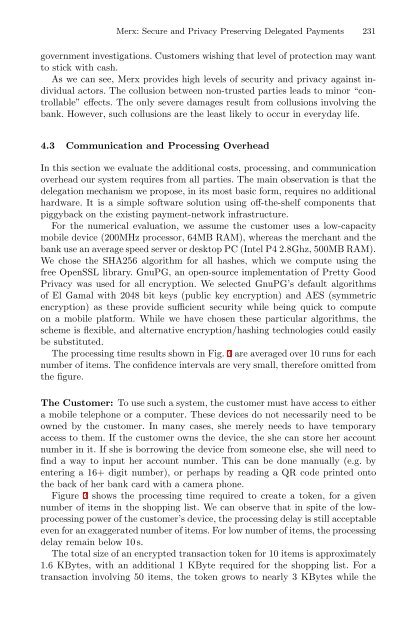Lecture Notes in Computer Science 5471 - tiera.ru
Lecture Notes in Computer Science 5471 - tiera.ru
Lecture Notes in Computer Science 5471 - tiera.ru
You also want an ePaper? Increase the reach of your titles
YUMPU automatically turns print PDFs into web optimized ePapers that Google loves.
Merx: Secure and Privacy Preserv<strong>in</strong>g Delegated Payments 231government <strong>in</strong>vestigations. Customers wish<strong>in</strong>g that level of protection may wantto stick with cash.As we can see, Merx provides high levels of security and privacy aga<strong>in</strong>st <strong>in</strong>dividualactors. The collusion between non-t<strong>ru</strong>sted parties leads to m<strong>in</strong>or “controllable”effects. The only severe damages result from collusions <strong>in</strong>volv<strong>in</strong>g thebank. However, such collusions are the least likely to occur <strong>in</strong> everyday life.4.3 Communication and Process<strong>in</strong>g OverheadIn this section we evaluate the additional costs, process<strong>in</strong>g, and communicationoverhead our system requires from all parties. The ma<strong>in</strong> observation is that thedelegation mechanism we propose, <strong>in</strong> its most basic form, requires no additionalhardware. It is a simple software solution us<strong>in</strong>g off-the-shelf components thatpiggyback on the exist<strong>in</strong>g payment-network <strong>in</strong>frast<strong>ru</strong>cture.For the numerical evaluation, we assume the customer uses a low-capacitymobile device (200MHz processor, 64MB RAM), whereas the merchant and thebank use an average speed server or desktop PC (Intel P4 2.8Ghz, 500MB RAM).We chose the SHA256 algorithm for all hashes, which we compute us<strong>in</strong>g thefree OpenSSL library. GnuPG, an open-source implementation of Pretty GoodPrivacy was used for all encryption. We selected GnuPG’s default algorithmsof El Gamal with 2048 bit keys (public key encryption) and AES (symmetricencryption) as these provide sufficient security while be<strong>in</strong>g quick to computeon a mobile platform. While we have chosen these particular algorithms, thescheme is flexible, and alternative encryption/hash<strong>in</strong>g technologies could easilybe substituted.The process<strong>in</strong>g time results shown <strong>in</strong> Fig. 3 are averaged over 10 <strong>ru</strong>ns for eachnumber of items. The confidence <strong>in</strong>tervals are very small, therefore omitted fromthe figure.The Customer: To use such a system, the customer must have access to eithera mobile telephone or a computer. These devices do not necessarily need to beowned by the customer. In many cases, she merely needs to have temporaryaccess to them. If the customer owns the device, the she can store her accountnumber <strong>in</strong> it. If she is borrow<strong>in</strong>g the device from someone else, she will need tof<strong>in</strong>d a way to <strong>in</strong>put her account number. This can be done manually (e.g. byenter<strong>in</strong>g a 16+ digit number), or perhaps by read<strong>in</strong>g a QR code pr<strong>in</strong>ted ontothe back of her bank card with a camera phone.Figure 3 shows the process<strong>in</strong>g time required to create a token, for a givennumber of items <strong>in</strong> the shopp<strong>in</strong>g list. We can observe that <strong>in</strong> spite of the lowprocess<strong>in</strong>gpower of the customer’s device, the process<strong>in</strong>g delay is still acceptableeven for an exaggerated number of items. For low number of items, the process<strong>in</strong>gdelay rema<strong>in</strong> below 10 s.The total size of an encrypted transaction token for 10 items is approximately1.6 KBytes, with an additional 1 KByte required for the shopp<strong>in</strong>g list. For atransaction <strong>in</strong>volv<strong>in</strong>g 50 items, the token grows to nearly 3 KBytes while the











